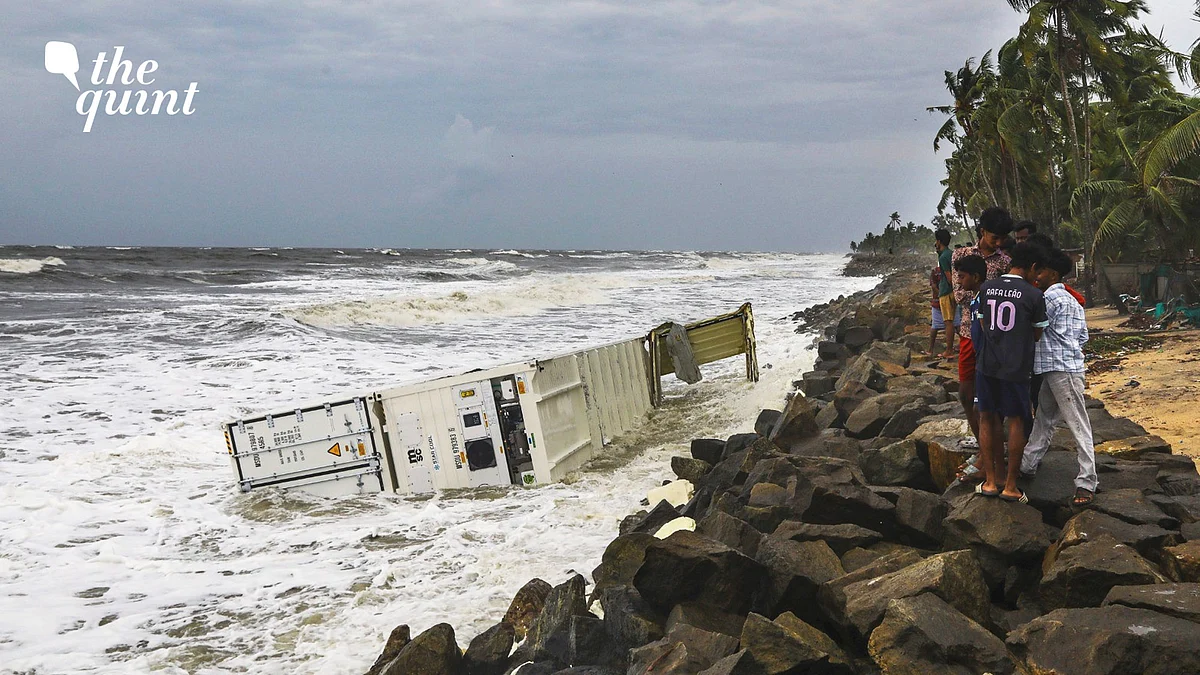Hazardous Cargo Spill Off Kerala Coast: Experts Warn of 'Lasting' Marine Damage
The possible repercussions include threat to fish stocks and sensitive coastal ecosystems in the Arabian Sea.

advertisement
Our on-ground climate journalism needs your ideas, insights, and support. Become a member.
"The reported pollutants can harm fish and marine life with an effect that may last for many years," noted scientist Dr N Anilkumar told The Quint days after a Liberian-flagged cargo ship capsized off the Kerala coast in the Arabian Sea.
As many as 640 containers of the cargo ship, including 13 carrying hazardous substances, sank along the coast near Kochi on Sunday, 25 May, triggering serious environmental concerns, particularly on the adverse impact on the marine ecosystem.
A container from the cargo ship that sank at the Kochi outer harbour drifted ashore in Anchuthengu, Thiruvananthapuram.
(Photo: PTI)
Dr Anilkumar, who's the chairman of the Kerala State Biodiversity Board (KSBB), added that the possible repercussions of the ship wreckage include threat to fish stocks, benthic organisms (creatures living on the seafloor), and sensitive coastal ecosystems (such as coral reefs, mangroves, seagrass beds, and wetlands).
100s of Containers Afloat in Sea, Many Wash Ashore
The cargo ship ELSA3, owned by the Mediterranean Shipping Company, capsized approximately 15 nautical miles southwest of Alappuzha district in Kerala.
According to an Indian Coast Guard communique, the cargo ship was carrying 13 containers with hazardous substances and 12 with Calcium Carbide, a toxic chemical compound which is considered dangerous to human health. When Calcium Carbide comes in contact with water, it generates acetylene, a highly inflammable gas.
The cargo ship also had "84.44 metric tonnes of diesel and 367.1 metric tonnes of furnace oil in its tanks," the communique said.
Off the sea coast of Alappuzha and Kollam districts, around 30 containers that had fallen into the sea were seen afloat. One container was towed to the Kollam port, and the containers seen close to the coastline in Alappuzha is set to be towed to the Kollam port, The Quint has learned.
Quantities of the Hazardous Leakage Unknown
So far, the agencies involved have not yet determined the exact quantities of hazardous substances that have leaked into the sea. However, it is clear that many containers have released their contents, posing a potential threat to marine ecology.
According to Dr A Bijukumar, scientist and professor at Marine Monitoring Lab, Aquatic Biology Centre, Kerala University, all the reported hazardous contents, including furnace oil and Calcium Carbide, would adversely affect the marine ecosystem.
"The Acetylene and Calcium Hydroxide that form when Calcium Carbide comes in contact with water, would adversely affect the aquatic life and ecosystem", he said.
However, he added, "But I don't see any sudden impact as many of the sea fish varieties have a tendency to keep off from the polluted regions, which might help reduce the impact."
The monsoon season typically supports high marine productivity. Dr Grinson Geroge, director at the Central Marine Fisheries Research Institute (CMFRI), said,
However, he said, "The ecological and economical impact would depend on the scale of the leakage," adding that the ICAR-CMFRI is closely monitoring the situation.
Calls For a Coordinated Effort to Control Spread
Most experts contacted by The Quint called for a "coordinated effort" of key agencies, including the Kerala State Biodiversity Board (KSBB), Indian National Centre for Ocean Information Services, CMFRI, Kerala State Pollution Control Board, and Department of Fisheries for an "integrated planning and action to ensure effective response".
"Long-term monitoring is necessary to understand and manage the environmental impact," said KSBB's Dr Anilkumar, adding that an immediate biodiversity study should be conducted to assess the impact.
In the meantime, emergency precautions are in full swing on the sea surface in the affected areas.According to a press release from the Indian Coast Guard, the vessels ICGS Saksham, ICGS Vikram, and ICGS Samarth have been deployed to assist in the response.
Apart from that, a Dornier aircraft loaded with equipment, safety gears, and dispersants will be used to diffuse and disperse the oil spread in the sea.
According to S Sreekala, Chairperson of the Kerala State Pollution Control Board, if the oil spread is thin, it will be removed using cleanup tools such as booms and skimmers. Booms are used to contain the oil within a specific area, while skimmers recover the oil by suction or adhesion without changing its physical or chemical properties.
Meanwhile, an emergency meeting chaired by Kerala Chief Minister Pinarayi Vijayan on Monday, 26 May announced its decision to rope in the service of all national- and state-level agencies. Five Rapid Response Teams (RRTs) from the Kerala Factories and Boilers Department are already working to bring the containers ashore. The Pollution Control Board has also deployed two RRTs to monitor the spread of the oil and carry out cleanup operations once it reaches the coast.
(Jose Kurian is a Wayanad-based senior journalist who has formerly worked with The New Indian Express and Deccan Chronicle. He now regularly writes for Onmanorama Online, Inmathi Online, and 101 Reporters.)